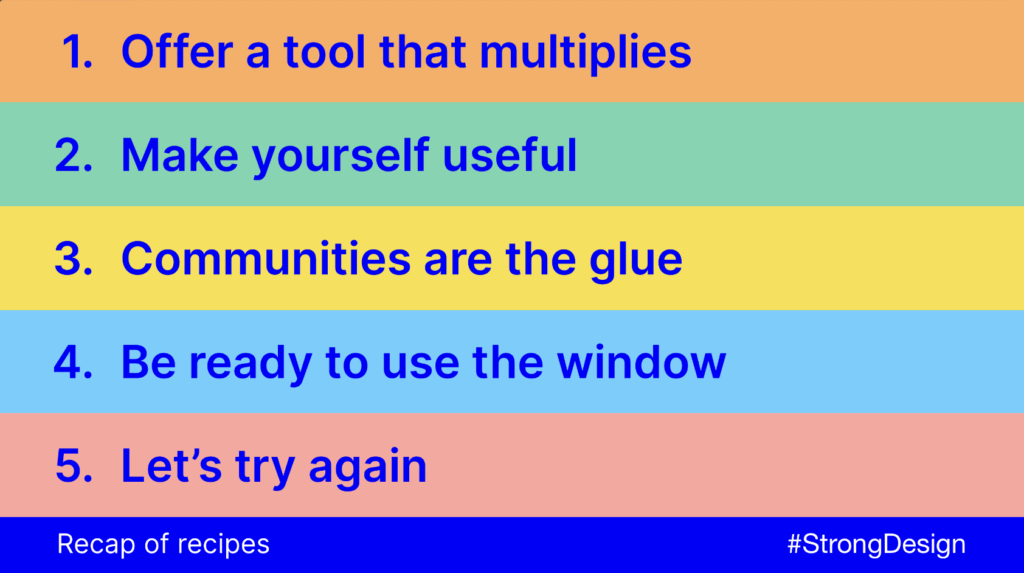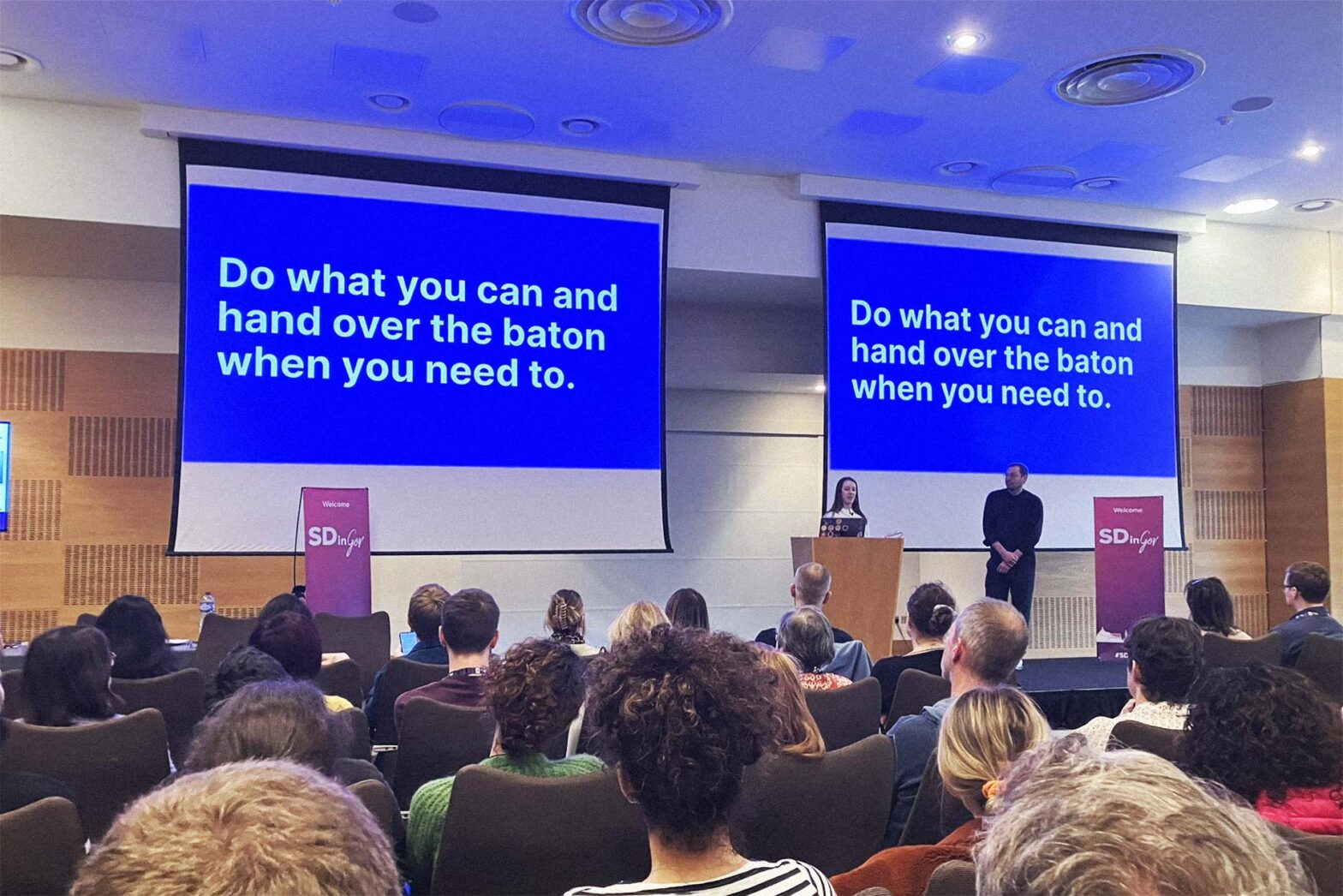While writing, I am on my way from Edinburgh to London – sitting on a train rushing along the Northern English east coastline.
In the late morning, Kara and I delivered our ‘long slog of public service design’ talk at the ‘Service Design in Government’ conference. We worked on it intensively the days before and still tweaked some slides in the morning. As it was all new, untested content, we were a bit nervous about how the talk would be received.
As our talk was on day 3 of the conference, we were able to witness how the themes from our talk emerged in other presentations early on. That allowed us to link our narrative to those of the colleagues who came before us.
The feedback we received on LinkedIn and Twitter was overwhelmingly positive. The topics we examined resonated with people, which was less surprising given the feedback we had received on the survey some weeks ago. It was then good to have follow-up conversations and hear from people what resonated the most with them.
It was nice to have both people we know and don’t know respond to our talk.
Talking about the things that are hard
“Doing the hard work to make things simple” is one of GDS’s original design principles. It has existed for over a decade and became a UK government design principle sometime around 2017. When the principle was written, the authors probably didn’t know how hard the necessary deep transformation would be – as they had only been in for a couple of years.
Now, there are thousands more people in UK government and in public sector organisations around the world. Many of them have common and shared challenges – realising how really, really hard change is.
When Lou Downe and others started talking about end-to-end, front-to-back, and cross-channel service transformation, people responded with an enthusiastic yes or at least a nod! Years later, there are still rather few examples of entirely reshaped services. Last week, Simon Manby from the UK Office of the Public Guardian shared a tweet in which he gave an update from Parliament of their legislative changes undergoing.
For a good half of a decade they have been trying to get an amendment discussed in the houses. And failed 2 times before. Taking another path this time – via a private members’ bill – and doing a huge amount of upfront consultation, additional research and engagement with Members of Parliament to navigate the process carefully.
Following the 3rd reading of the bill, things could come for a vote shortly, and then, according to Simon, the real work would start. His team members Kaz, Rachel and Stephen discussed this in their slot ‘This is not service evolution, it’s service revolution’.
Kara and I referenced the tweet and their work and put it into the context of different timelines and speeds of change. Building on a graphic from Dan Hill’s book ‘Dark Matter and Trojan Horses’, I drew an extended public sector version. It shows broadly possibilities for changing things – from very flexible team sprints to barely movable things like governance, culture and the very nature of government.

In our talk, we argued that teams need to make themselves aware of the domain-specific things that are related to their service or project, map them out and work with them. The Lasting Power of Attorney team trying to get a piece of primary legislation changed had to deal with the most immovable things of all: the nature of government, culture and governance structures.
To deal with the long slog, aka complex change with a complex system, we extracted 5 recipes we have seen working at different levels and various manifestations.

The 5 recipes we presented are these:
- Offer a tool that multiplies – Create tools or frameworks to establish ways of working, build capability, and demonstrate value
- Make yourself useful – Demonstrate value by delivering something to build trust – even if you don’t consider it ‘the right thing’
- Communities are the glue – Lean into getting to know, supporting, and learning from the people we work with
- Be ready to use the window – Have your ambitions ready so that when the opportunity arises you are ready to put your ideas forward
- Let’s try again – If you are blocked in your current team or organisation, be open to trying somewhere else
We will revise the talk in the coming days and create a non-public sector version. Kara and I will speak at the Service Design Network Global Conference in Berlin on 5 October. The audience will be different, and certain references to established building blocks in the public sector – like the Service Standard, the cross-org Slacks, and legislative changes – will require explanation or replacement. Having spoken to former colleagues and friends working in fields like health tech, the overall message and our recipes should transcend the public sector and be widely applicable. We will have to carve that out clearly.
Building a user-centred design community, connections and trust
On Thursday morning, with terrible internet in the hotel, my co-runner Maria and I ran the first official community gathering as part of our user-centred design community of practice in the public sector NExT network. After the introductory event in July to validate the interest, we had 52 people signing up this time and 37 joining us for 2.5 hours to discuss design systems and component libraries in the German public sector.
Guesstimating there could be a dozen design systems in the German public sector already, I reached out to some of the people I knew or knew of. So, we had 4 talks confirmed – from city, communal, and departmental levels.
We had vivid discussions, too little time, and again, people and even organisations I had never heard of. It illustrated that established network structures linked to countless people can do much more to get people to gether than a few very well connected individuals. NExT as an entity has been remarkable at linking all levels of government and part of the public sector – more than any organisation in the UK has been able to do that.
We didn’t get to any substantial discussion about collaboration on design systems in this session. So we will have to continue to meet around this topic. As NExT can be a neutral facilitator, it might be the best umbrella to meet under.
NExT activities continue with a full-day remote bar camp in mid-October, and I will use a session to discuss the application of the Service Standard there. In November, we plan to run the next community gathering – on a topic we still need to decide.
What’s next
After arriving by train, I’ll take the train back to Berlin. But I’m making a detour via Paris and 2 days off next week to explore art and food. Then, there’s a good week until the Service Design Network Global Conference and its satellite events left. So, I will prepare that content, do several interviews with candidates, and catch up with all the other things I didn’t get to do this week.

